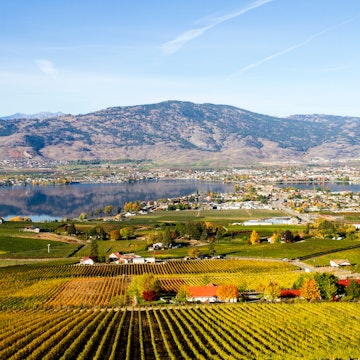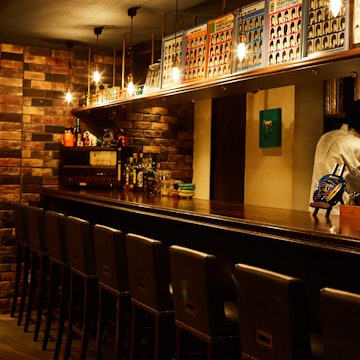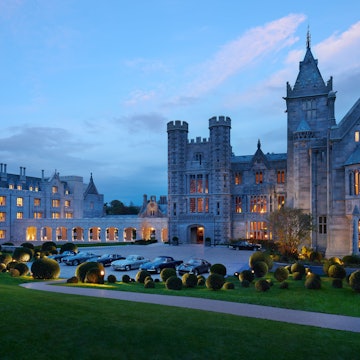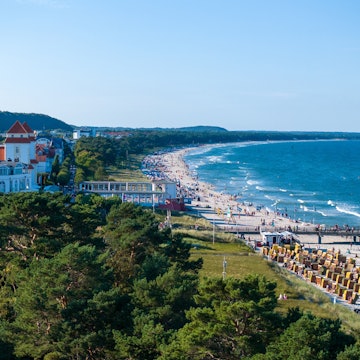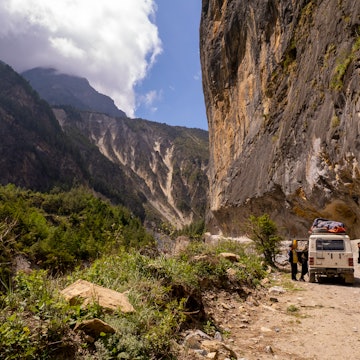

Food from Little Chief on Tsuut’ina Nation. Megan Frye
Canada’s big-sky province has long been synonymous with cowboy culture: big nod to the annual Calgary Stampede, which has been running since 1912 and the fact that the province is home to the largest number of farms in the country. Yet look closer and you’ll taste an older, deeper story. From prairie grasslands to glacier-fed rivers, the land continues to supply the bison, berries, roots and herbs that have nourished First Nations peoples for millennia.
Today, Indigenous-led restaurants, market stalls and lodge kitchens transform those ancestral ingredients and flavors into dishes that speak to modern tastes while protecting cultural memory. “First Nations” refers to the original inhabitants of the land now known as Canada, representing a diverse group of cultures, languages and histories that were present for thousands of years before European colonization. There are more than 630 First Nations communities spread across Canada.
Many First Nations communities were forcibly displaced or assimilated by government policies as Canada’s European population advanced, resulting in generational trauma and loss of traditions and identity.

What is Indigenous cuisine?
In Alberta, Treaties 6, 7 and 8 were signed in the late 1800s between Indigenous nations and the Canadian government. These were meant to outline how the land would be shared as settlers moved west. But while settlers gained land and resources, Indigenous communities often didn’t receive what had been promised, like education, health care or protection of their rights. Today, many Indigenous people are still fighting to have those original agreements honored as living, legal commitments. Treaties are not historical artifacts; they’re legally binding agreements that still apply today.
Alberta is one of the most culturally and geographically diverse Indigenous regions in Canada, home to 48 First Nations across three treaty areas. It is the homeland of the Métis Nation and home to a mosaic of food traditions shaped by plains, boreal forest and Rocky Mountain ecosystems.

Classic ingredients of the region include bison, elk, deer, lake trout, pickerel, wild rice, Saskatoon berries and medicinal plants such as sage and sweetgrass. Historically, meat was roasted or stone-boiled (a method of cooking without direct fire), berries were pounded into pemmican and roots were pit-baked or dried for winter. Colonization disrupted those practices, but a growing movement of Indigenous chefs is revitalizing them, pairing hot-skillet bannock (a dense Indigenous bread made from flour, water and fat) with sweet-sour berry soups or simmering bison stew over open flame, and inviting diners to savor the flavors of the land.

Little Chief, Tsuut’ina Nation
Best for something totally unexpected
At this upscale restaurant with floor-to-ceiling windows located inside Grey Eagle Resort & Casino, on the Tsuut’ina Nation, just outside of Calgary, Chef Brandon Dashnay, whose son is part of the nation, frames each plate as a bridge between cultures. “It’s not about impressing. It’s about connecting,” he says. In one dish, for instance, buffalo raised in Nation paddocks becomes tartare topped with juniper ash (a traditional Indigenous ingredient made by burning juniper branches and using the mineral-rich ash to boost calcium and flavor), while elsewhere on the menu, foraged and fermented chokecherries form a tangy glaze for seared tenderloin crowned with crispy salmon skin.
Fan favourites like elk-meatball pizza and powwow taco poutine (with braised beef, crispy onions and smoked cheddar) translate tradition, while house-cured duck prosciutto explores connection. Dashnay sums up Little Chief’s mission: “If guests leave with deeper respect for land and culture, we’ve succeeded.”
Bannock booth, Calgary Stampede
Best for those who aren't worried about their diet
Elbow River Camp is an Indigenous-run cultural gathering spot within the Calgary Stampede; it’s been anchoring the event since 1912 when it was called Indian Village. Its beating heart is the humble bannock booth, run by families from Treaty 7 nations. Order the fried bread plain or with a slew of unique toppings. Drizzle it with Alberta honey or load it with shredded bison and green-onion butter. Between bites, watch powwow dancers, browse beadwork stalls and chat with tipi owners whose ancestors traded here centuries before Calgary existed. The Stampede lasts ten days each July, incorporating many sides of Alberta’s history.
Rouge, Calgary
Best for a romantic dinner
Calgary fine dining meets Métis foraging at Rouge, in an 1891 red-brick mansion beside the Bow River, not far from downtown. The elegant space is warm and relaxed, filled with art and with views of its luxurious garden.
Chef Dean Fast roams the garden each day for nasturtiums and heirloom tomatoes, then heads a couple of hours west, deep into the Canadian Rockies, for morels or east for prairie sage. Dinner might feature mushroom-ricotta gnocchi, potato-crusted halibut with spruce butter, or wild-boar chop glazed in chokecherry jus, each plate echoing Fast’s credo of resourcefulness, while diners are guided through their meals with a detailed description of the dishes and where the ingredients were procured.
The Ridge, Kananaskis
Best for dining with a view
Thirty-five minutes west of Calgary, on the Stoney Nakoda Nation, the Indigenous-owned The Ridge is in a modern timber lodge with breathtaking views overlooking the rolling foothills of the snow-capped Rockies. Start with sage-bison chili, move to pan-seared mountain pickerel finished in maple-citrus glaze, and finish with berry crumble baked under cedar smoke. In winter, skiers fuel up on wild-rice porridge at breakfast, and in summer, hikers grab bison-burger picnics to go. Elders from the community are often present and willing to share the stories behind the Indigenous artwork lining the walls.
Métis Crossing, Smoky Lake
Best for a country dining experience
Eighty minutes northeast of Edmonton is the Métis Crossing cultural centre, where Chef Ron Ladouceur serves true farm-and-forest-to-table cuisine. Pan-fried pickerel cheeks arrive with cattail-heart relish; slow-braised bison rests on garden beets glossed with maple vinegar. A greenhouse supplies year-round greens, tightening the site’s self-sufficiency loop. Before dining, join a Métis knowledge keeper for a sash-weaving lesson or a horse-drawn wagon ride along the North Saskatchewan River. If you’re lucky, especially from September through March, you’ll catch the Northern Lights after dinner.
Twisted Fork, Saint Paul
Best for small-town friendly vibe
Chef Debra Poulin grew up canning beside her Ontario grandmothers. At Twisted Fork, about two hours east of Edmonton, she channels that self-sufficient spirit into Treaty 6 terroir. Summer brings rhubarb-ginger jam for pork-belly sliders, while autumn means cranberry-sage glaze on roasted duck. Gluten-free diners cheer her seed-flour bannock, and cocktail lovers order the garden gimlet, muddled with herbs snipped that morning. Colorful walls, playlists that swing from Tibetan throat-singing to indie folk, and servers who know everybody’s first name complete the vibe.

Bernadette’s, Edmonton
Best for fine dining
In a heritage brick building in downtown Edmonton, near the North Saskatchewan River, Mushkego Cree chef Scott Iserhoff and his wife Svitlana Kravchuk, of Ukrainian descent, deliver not only a stellar a la carte selection, but also one of Canada’s most special tasting menus: seven courses, seven pairings (natural wines or zero-proof beverages) and limited seating. Think bison cheek with sunchokes, raw elk with shallots and Saskatoon-berry tart.
“Every dish created has a story,” explains Iserhoff, who has mentored a largely Indigenous brigade between different kitchens, challenging the expectation that Indigenous chefs only cook what people might expect, like bison and fry bread. “To be an Indigenous chef, we often get pigeonholed… they never take into account our training under various chefs throughout our careers.” At Bernadette’s, the stereotypes fall away, one plate at a time.
Culina, Edmonton
Best for a healthy fare downtown
Métis chef Brad Lazarenko planted the Culina flag in 2004 with a single neighborhood bistro; two decades on, his catering offerings focus on locally sourced, nutritious food products that remain fiercely local. When you’re visiting Edmonton, Culina To Go offers tourtière and vegan stew for busy folks downtown. Profits flow back into community causes like food security, proving hyperlocal cooking can also be hyper-generous.
Paperbirch by Chartrand, Edmonton
Best for market-fresh ingredients
Weekend mornings inside Old Strathcona Farmers’ Market belong to Cree chef Shane Chartrand’s Paperbirch stall. Whatever his vendor neighbors harvested at dawn appears by brunch: duck-egg French toast with berry-bark syrup, elk sausage on three sisters succotash, or wild-mushroom eggs Benedict atop sage-bannock biscuits.
Beyond market hours, Chartrand occasionally hosts candle-lit five-course dinners, where each plate comes paired with oral history from the region and its people. Named for the resilient birch, Paperbirch invites guests to “learn, laugh, and connect” through food.
Homefire Grill, Edmonton
Best for laid-back dining
West-end favorite Homefire Grill borrows its name from the sacred communal fire and channels that warmth into a cedar-and-stone dining room. This is truly a casual setting, making it a great place for the whole family to enjoy a meal. The signature bison rib-eye arrives medium-rare beside roasted root vegetables in a sweetgrass demi-glace; lighter dishes include smoked-trout salad on warm bannock. A crackling hearth anchors the space, and staff gladly decode Treaty 6 references on the cocktail list (pro tip: try the Saskatoon-gin berry treaty) even as tourists mingle with local lunch-hour regulars.










